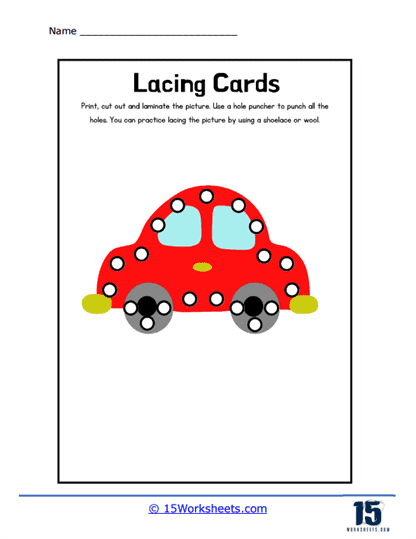Hole Punch Worksheets
All About These 15 Worksheets
Note: It’s important for preschoolers to use hole punch worksheets under adult supervision, especially if they are very young, to ensure they use the hole punch safely and effectively.
Preschool is a pivotal stage in a child’s development, marked by significant growth in fine motor skills, cognitive abilities, and creativity. Engaging activities that promote these skills are crucial for laying a strong foundation for future learning. The collection of Hole Punch worksheets for preschool students offers an invaluable resource for educators and parents to nurture fine motor skills, hand-eye coordination, and creativity in young learners. These worksheets provide a hands-on, interactive approach to learning that not only sharpens motor skills but also fosters creativity and problem-solving.
What Are Hole Punch Worksheets?
Hole punch worksheets for preschoolers were created to help children develop fine motor skills and hand-eye coordination. These worksheets feature various shapes, images, or patterns, with small circles or dots indicating where the child should use a hole punch to create holes.
They combine interactive, hands-on activities with educational content, fostering a range of skills essential for a child’s development. From fine motor skills to early literacy and numeracy, these worksheets provide a well-rounded learning experience that prepares children for future academic endeavors.
Benefits Of Hole Punch Worksheets To Students
This simple activity can improve student fine motor skill development. Using a hole punch requires precise hand movements and finger strength, making it an excellent activity for developing fine motor skills in preschool-aged children. It helps them refine their hand muscles and coordination, which are essential for tasks like writing and drawing.
The worksheets are composed of printed pages with various activities, illustrations, and exercises designed to be visually engaging and developmentally appropriate for children aged 3 to 5. Alongside the worksheet, preschoolers are provided with a hole puncher, which is a hand-held device that creates holes in paper when pressed. The key feature of Hole Punch worksheets is that children are encouraged to use the hole punch tool to complete tasks, thus combining fine motor skill development with cognitive learning.
This skill requires a good amount of hand-eye coordination. To punch holes accurately on the designated spots, children must coordinate their hand movements with their visual perception. This enhances their hand-eye coordination, an important skill for various activities throughout life.
Hole punching requires concentration and patience, as children must align the hole punch correctly and apply sufficient pressure to punch through the paper. This can help them develop their ability to focus and persevere through tasks. As children complete these worksheets, they can also learn about colors, shapes, numbers, and letters, depending on the content. It can be an engaging way to introduce or reinforce early learning concepts.
Conclusion
This collection of Hole Punch worksheets for preschool students serves as a valuable educational tool that nurtures fine motor skills, hand-eye coordination, creativity, and problem-solving abilities. These worksheets provide an engaging and interactive way for young learners to engage with shapes, patterns, letters, and numbers, setting a strong foundation for future academic success.
Additionally, hole punch activities encourage independence and self-reliance, empowering children to complete tasks on their own. By incorporating these worksheets into early education, educators and parents can help children develop essential motor skills, stimulate their creativity, and instill a sense of confidence and competence that will serve them well throughout their educational journey.
















